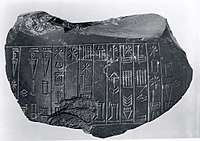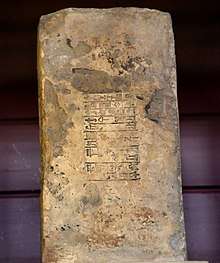Amar-Sin
Amar-Sin (Akkadian: 𒀭𒀫𒀭𒂗𒍪: DAmarDSîn, after the Moon God Sîn", the "𒀭" being a silent honorific for "Divine"), initially misread as Bur-Sin (c. 2046-2038 BC middle chronology, or possibly ca. 1981–1973 BC short chronology) was the third ruler of the Ur III Dynasty. He succeeded his father Shulgi (ca. 2029–1982 BC).[1] His name translates to 'immortal moon-god'.
| Amar-Sin 𒀭𒀫𒀭𒂗𒍪 | |
|---|---|
| |
 An architectural foundation-nail figurine depicting king Amar-Sin himself carrying the builder's wicker traybasket, and a cuneiform dedication tablet of Amar-Sin | |
| King of the Neo-Sumerian Empire | |
| Reign | c. 2046 BC – 2038 BC |
| Predecessor | Shulgi |
| Successor | Shu-Sin |
| Dynasty | 3rd Dynasty of Ur |
| Father | Shulgi |
Reign
Year-names are known for all nine years of his reign. These record campaigns conducted against Urbilum, and several other regions with obscure names: Shashrum, Shurudhum, Bitum-Rabium, Jabru, and Huhnuri.[2] Amar-Sin is otherwise known to have campaigned against Elamite rulers such as Arwilukpi of Marhashi, and the Ur Empire under his reign extended as far as the northern provinces of Lullubi and Hamazi, with their own governors. He also suppressed a rebellion in Assur where he appointed an Akkadian governor, Zariqum as confirmed by his monumental inscription.[3]
Amar-Sin's reign is notable for his attempt at regenerating the ancient sites of Sumer. He apparently worked on the unfinished ziggurat at Eridu.[4] Eridu was abandoned during his reign. Salinity problems had made agricultural pursuits in this region unprofitable.
The Babylonian Weidner Chronicle records the following: "Amar-Sin... changed the offerings of large oxen and sheep of the Akitu festival in Esagila. It was foretold that he would die from goring by an ox, but he died from the [scorpion?] 'bite' of his shoe."
Year names of Amar-Sin
All the year names of Ibbi-Sin are known, documenting the major events of his reign. The main year names are:
1a. Year: "Amar-Suen is king"
1b. Year: "Harshi and Kimaš were destroyed"
2a. Year: "Amar-Suen, the king, destroyed Urbilum"
5a. Year: "Enunugalanna was installed as en-priest of Inanna in Uruk"
6b. Year: "Amar-Suen, the king, destroyed Shashrum for the second time and Shurudhum"
7b: Year: "Amar-Suen, the king, destroyed Bitum-rabium, Jabru, their territories and Huhnuri"— Main year names of Amar-Sin.[5]
Artifacts
 Statue fragment beariing incised cuneiform inscription of Amar-Sin,ca. 2046–2038 B.C. Neo-Summerian
Statue fragment beariing incised cuneiform inscription of Amar-Sin,ca. 2046–2038 B.C. Neo-Summerian- Stamped mud-brick of Amar-Sin
 Fired clay brick stamped with the name of Amar-Sin, Ur III, from Eridu. British Museum.
Fired clay brick stamped with the name of Amar-Sin, Ur III, from Eridu. British Museum. Cuneiform tablet impressed with cylinder seal. Receipt of goats, ca. 2040 BC, year 7 of Amar-Sin. Neo-Summerian.[6]
Cuneiform tablet impressed with cylinder seal. Receipt of goats, ca. 2040 BC, year 7 of Amar-Sin. Neo-Summerian.[6].jpg) Cuneiform tablet impressed with cylinder seal. Receipt of goats, ca. 2040 BC, Neo-Summerian (drawing).[6]
Cuneiform tablet impressed with cylinder seal. Receipt of goats, ca. 2040 BC, Neo-Summerian (drawing).[6].jpg) Inscription with the name "Amar-Sin"
Inscription with the name "Amar-Sin" Dedication tablet of Amar-Sin
Dedication tablet of Amar-Sin
See also
| Wikiquote has quotations related to: Amar-Sin |
References
- John Bagnell Bury; et al. (1925). The Cambridge Ancient History. Cambridge University Press. p. 607. ISBN 0-521-07791-5.
- Year-names for Amar-Sin
- Zariqum does not appear on the Assyrian King List tablets, but is usually placed by archaeologists between Akkiya and Puzur-Ashur I. He is well known from contemporary documents as a career governor who was also appointed over Susa at various times between Shulgi year 40 and Shu-Sin year 4. See Potts, The Archaeology of Elam, p. 132.
- Mallowan, Max, "The Development of Cities from Al-U'baid to the end of Uruk 5" (Cambridge Ancient History)
- "Amar-Sin year names".
- Spar, Ira (1988). Cuneiform Texts in The Metropolitan Museum of Art Volume I Tablets Cones and Bricks of the Third Ur Dynasty (PDF). The Metropolitan Museum of Art. p. 38, Nb 35.
| Regnal titles | ||
|---|---|---|
| Preceded by Shulgi |
King of Ur, Sumer and Akkad ca. 21st century BCE |
Succeeded by Shu-Sin |